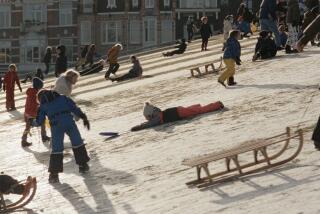Austrian town’s dark past reemerges
GUSEN, AUSTRIA — Garden Street, Flower Street, Park Street -- the bland names can be found in any Austrian village. The solid, two-story houses that line these streets, the BMWs in the driveways, the neatly trimmed hedges, potted geraniums and inevitable garden gnomes speak of contented middle-class normality.
A few residents always knew the truth but chose to ignore it. Occasionally, they dug into their backyards to install swimming pools and were startled to find human skeletons.
Even then, there was a reluctance to face the fact that their comfortable suburban community was built on the remains of one of Nazi Germany’s most dreadful concentration camps.
Few people outside academic circles have heard of Gusen. It is not nearly as well known as the infamous Mauthausen Camp, four miles away, even though Gusen was larger, claimed more victims and, in the Nazi scheme of things, was far more important.
Christoph Mayer, 32, an artist who spent a happy childhood in this community, believes it is time to confront reality.
His specialty is interactive art, and he has designed a remarkable audio tour during which visitors walking through Gusen can listen on headphones to the recollections of survivors, of townspeople who watched the terrible events unfold and, most disturbingly, of camp guards who perpetrated the crimes.
Walking through the quiet village, it is discomfiting to learn that the elegant mansion with the distinctive masonry archway, now occupied by a wealthy family, was once the SS headquarters where political prisoners were tortured and slain in the basement.
It is equally unsettling to discover that a comfortable, one-story home with a fine stone porch once served as the camp brothel, where female inmates were forced to work. Male slave laborers whose diligence pleased their masters were rewarded with brothel privileges.
A busy pub occupies the spot where the camp’s main watchtower stood. Playground Street follows the path of the old rail line that transported inmates to the camp.
By contrast, the nearby Mauthausen site has been preserved as a national memorial to the victims of Nazi crimes. It receives tens of thousands of visitors each year.
“In Mauthausen, you feel you are in a sacred place. You feel you shouldn’t even eat an ice cream there. And then Gusen -- everything is so normal, it is like nothing happened here,” Mayer said.
Some residents are unhappy with Mayer’s project. Several have put up no-trespassing signs.
“People are worried about their property values,” said Ferdinand Naderer, a former deputy mayor. “They are worried that if a lot of visitors are coming here to look at their houses, they will be made to feel guilty for living here.”
But Naderer, 57, an engineer, said he supports the project.
“I’m even proud to live on this devastating field of horror where the grass has literally grown over our history,” he said. “I think we can use this project to show that evil can be overcome by good things like liberal democracy and hard work.”
Unlike Auschwitz-Birkenau or Treblinka, Gusen was not an extermination camp. It was, instead, a camp where the slaves who supplied the Nazi war machine were worked to death. An estimated 37,000 died here.
Frau Traude, whose voice is heard on Mayer’s audio walk, was 11 when the SS arrived to establish the camp just a few yards from her village.
“We were quite smitten with the Germans because they were so nice and sweet,” said Traude, who is now 80 and asked that her last name not be used because she still lives in the area.
She was less smitten a few years later when she saw the massacre of children who were tied up in cloth sacks and heaved against a stone wall by camp guards.
The Gusen site was originally chosen for its proximity to the granite quarries that supplied the stone for Third Reich architect Albert Speer’s monumental building projects. Later, it became an important center for small-arms production. In its final phase, a 50,000-square-yard underground space was built to house production facilities for a new Messerschmitt jet.
“It was the second-biggest and most important underground plant for Nazi Germany, and the [Messerschmitt project] represented the last hope of Hitler and Himmler for turning the tide of the war,” said Rudolf Haunschmied, a resident who unlocked many of Gusen’s secrets. His work inspired Mayer’s project.
Gusen was liberated May 5, 1945, by the U.S. Army. By that late point in the war, it had become an overcrowded transit camp for prisoners from Auschwitz and other camps that the Nazis were evacuating ahead of the advancing Soviet army.
The Americans were stunned by the mountains of corpses, the emaciated prisoners, the rampant disease. U.S. Army Lt. Col. Milton Keach took command of the area and immediately ordered residents of Gusen to be rounded up and brought into the camp to see the crimes that had been committed in their name.
The men of Gusen were ordered to dig the mass graves and place the corpses in the ground. The women were ordered to cover the bodies with dirt. Traude, 18 at the time, was among the women who performed this task.
“My mother and I had to shovel soil onto the bodies,” she said in a recent interview. “We tried to look away, but the soldiers wouldn’t let us. They grabbed our heads and forced us to look.”
A few weeks later, the Americans handed command of the area to the Soviet army, and Gusen began its long slide toward comfortable oblivion.
More to Read
Sign up for The Wild
We’ll help you find the best places to hike, bike and run, as well as the perfect silent spots for meditation and yoga.
You may occasionally receive promotional content from the Los Angeles Times.






